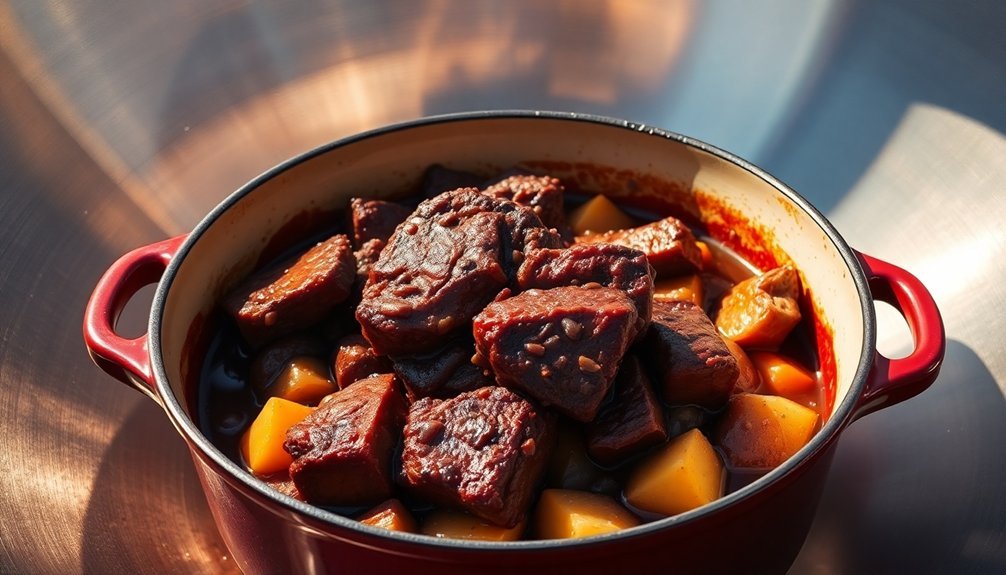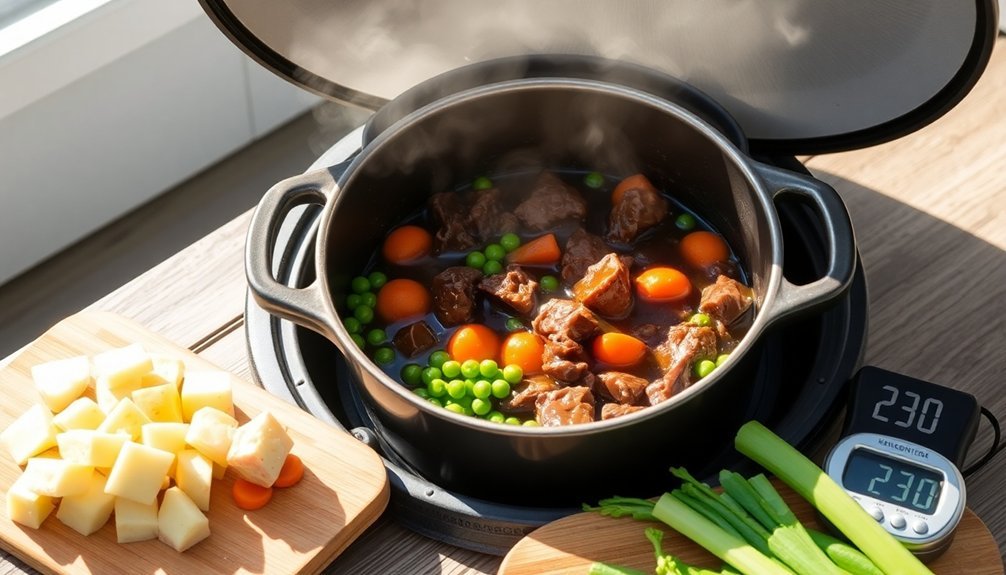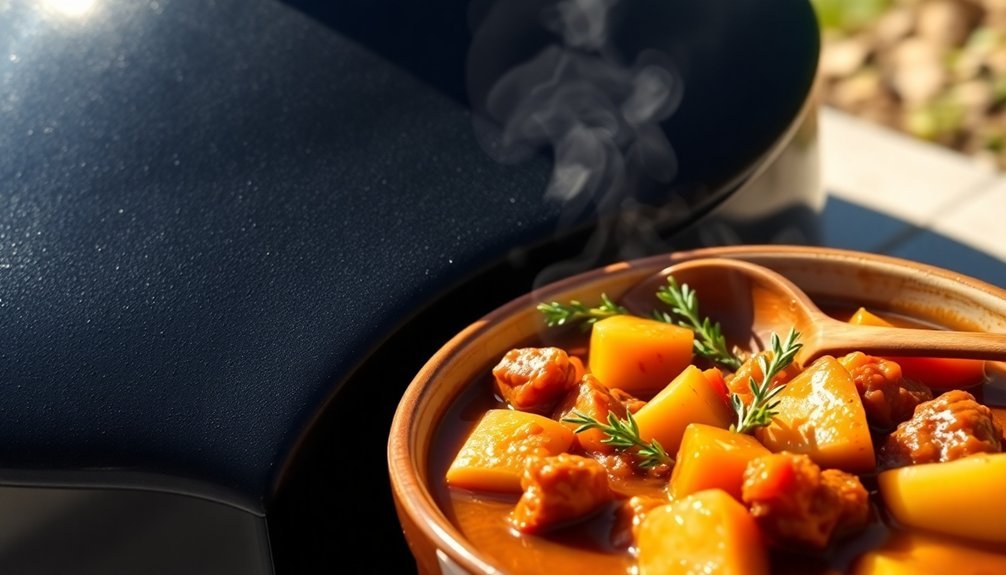For rich solar oven beef stew, you'll want to focus on three key techniques. First, pat your meat completely dry and brown it in larger cuts before cooking, using a baking soda solution to enhance browning if desired. Second, position your solar oven directly toward the sun and adjust every 30-45 minutes, maintaining temperatures between 150-225°F for ideal results. Third, add vegetables strategically: start with hardy vegetables like sweet potatoes and onions, introduce green beans halfway through, and add quick-cooking items like peas in the final 30 minutes. These foundational steps will reveal the full potential of your solar cooking adventure.
Perfect Meat Browning Techniques

When browning meat for your solar oven stew, the size and preparation of your cuts will make or break the final result.
You'll want to work with larger pieces rather than small cubes, as this helps prevent excess moisture release that can lead to steaming instead of browning. Don't use pre-packaged "stewing beef"; instead, select a quality chuck roll that you can cut yourself.
Before you start browning, pat your meat dry and consider treating it with a baking soda solution (¾ teaspoon baking soda mixed with 2 tablespoons water per 2 pounds of meat) for 15-20 minutes. This raises the surface pH, improving browning and moisture retention. The solution promotes rich caramelized flavor through enhanced Maillard reaction.
Heat your stainless steel or cast iron pan to medium-high and add a small amount of high smoke point oil.
Don't overcrowd the pan – work in batches if needed. Let each piece brown undisturbed for several minutes before flipping. Once you've achieved a good sear, let the meat rest briefly before cutting it into your desired size.
This resting period allows the juices to redistribute, ensuring your stew meat stays tender and flavorful.
Temperature Control Made Simple
The key to maintaining consistent temperatures in your solar oven lies in precise positioning and monitoring. You'll need to face your oven directly toward the sun and adjust its position every 30-45 minutes to maintain ideal heat collection. Use your oven's reflective flap to guarantee the cooking surface remains perpendicular to the sun's rays.
For precise temperature control, install a reliable thermometer or Type-K thermocouple to monitor your cooking temperature. Consider using multiple heat retention models for consistently maintaining temperature on overcast days. You'll want to maintain temperatures between 150-225°F for perfect beef stew results. If temperatures climb too high, simply adjust the oven's orientation slightly away from direct sunlight.
| Time of Day | Temperature Action | Target Range |
|---|---|---|
| Morning | Preheat oven | 150-175°F |
| Mid-morning | Monitor rise | 175-200°F |
| Noon | Peak heat control | 200-225°F |
| Early afternoon | Maintain heat | 175-200°F |
| Late afternoon | Heat retention | 150-175°F |
Use your oven's gimbal design for easy North-South rotation, and make sure you've positioned it in a wind-sheltered spot. Dark-colored, lidded cookware will maximize heat absorption and retention while your stew simmers to perfection.
Timing Your Vegetable Additions

Mastering vegetable timing transforms an ordinary solar-cooked stew into a perfectly balanced dish. Start by adding sweet potatoes, red bell peppers, onions, and garlic during the initial 2-3 hours of cooking. You'll want to sauté the onions and garlic beforehand to enhance their flavors. Green beans and zucchini can be added halfway through cooking for optimal tenderness.
For root vegetables like carrots, you'll need to be more strategic. Add them about 30 minutes before the stew is done to prevent mushiness. You can steam them separately until just tender, then incorporate them into the mix. Slice your carrots 1/4 inch thick to guarantee even cooking throughout.
Quick-cooking vegetables require careful timing. Add frozen peas during the final 30 minutes, or if you're using fresh peas, stir them into the fully cooked stew and let stand for 5 minutes. For the freshest taste and brightest color, add parsley and other leafy greens right before serving.
Remember to test your vegetables for tenderness as cooking temperatures in solar ovens typically range from 250-300°F. You can use stackable pots or separate cooking vessels to manage different cooking times effectively, assuring each vegetable maintains its ideal texture.
Frequently Asked Questions
Can I Add Wine or Beer to My Solar Oven Stew?
Yes, you can add wine or beer to your solar oven stew. They'll enhance flavor and help tenderize the meat. Just keep in mind you'll need consistent sun exposure for proper cooking and reduction.
Should I Add Flour or Cornstarch to Thicken the Stew?
You'll get better results with cornstarch since it works well at lower temperatures. Mix 1 teaspoon with cold water, add it near the end of cooking, and make sure you bring it to a boil.
How Much Water Should I Add to Prevent the Stew From Drying?
You'll need enough water to cover your ingredients by about 1 inch initially. Keep checking and add 1/4 cup at a time if it's getting dry. Don't overfill, as vegetables release moisture too.
What Herbs Work Best in Solar Oven Beef Stew?
You'll get the best results using rosemary, thyme, and sage added two-thirds through cooking. Don't forget to sprinkle fresh parsley at the end. These herbs create a perfect savory blend for your stew.
Can I Leave the Stew Unattended While It Cooks in the Solar Oven?
You can leave your solar oven unattended if you're using a box or panel cooker. Just position it ahead of the sun's path and check every 1-2 hours. Don't leave parabolic cookers unattended.
In Summary
You'll find solar oven beef stew isn't just about tossing ingredients together and hoping for the best. By mastering proper meat browning, maintaining steady temperatures, and adding vegetables at the right time, you're guaranteed a rich, flavorful result. Don't let cloudy days discourage you – with these three key techniques under your belt, you'll create tender, succulent stews every time you harness the sun's power.





Leave a Reply